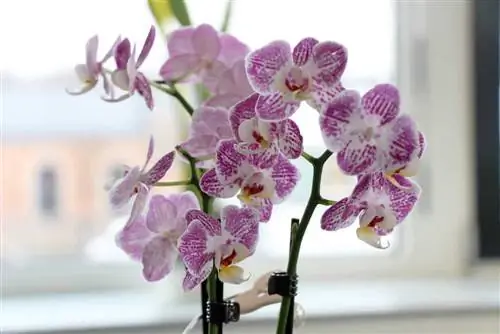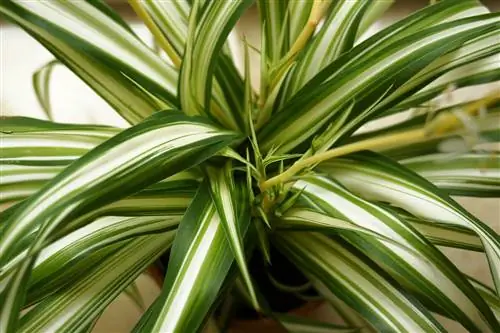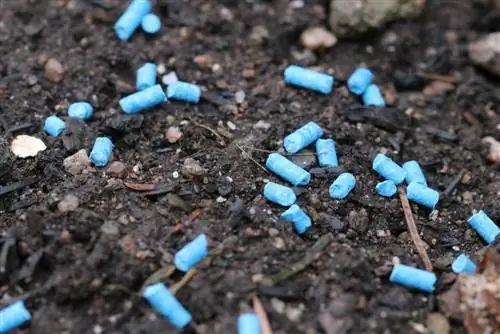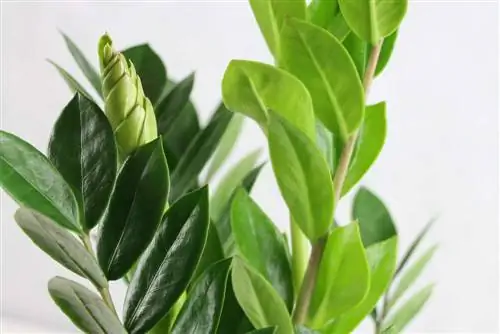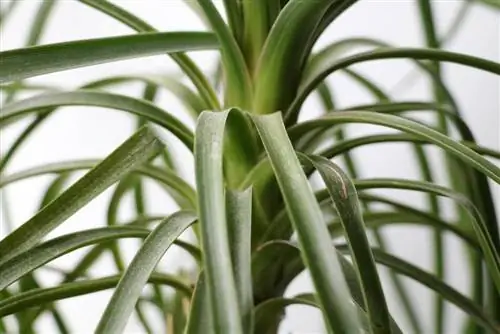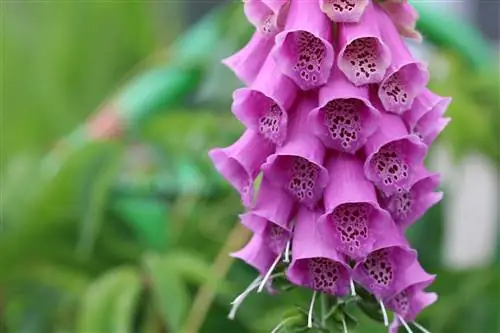- Author admin [email protected].
- Public 2023-12-17 03:39.
- Last modified 2025-06-01 06:48.
In Europe alone, around 34 million of these exotic plants are sold annually by Dutch marketers - and the trend is rising rapidly. In the worst case scenario, however, these or other orchids can mean death for cats.
Cats like to nibble on plants
Cats are immensely curious - and like to try a bite of this houseplant, a bite of that. Outdoor birds like to roam through the garden and not only look for careless birds or mice, but also nibble on the grass or other plants from time to time. This behavior is completely normal and cannot be trained out of house tigers.
Why cat owners should pay attention to the safety of houseplants
Many cat owners believe that their pet knows exactly which plants are poisonous and which are not. However, this is a fallacy, because how should a domesticated pet know whether certain plants are poisonous or non-toxic?
This knowledge is not innate in cats, but is taught to the kittens by their mothers - so it is a learned behavior, which, however, is almost no longer present, especially in indoor cats. No wonder there are so many cases of poisoning from house plants and other substances unsuitable for cats in vet waiting rooms.
Provide problematic houseplants with cat protection
If you want to spare your cat such a fate, you should make your apartment cat-proof. Of course, this includes avoiding houseplants that are poisonous to cats - or at least placing them out of the reach of cats. Hanging baskets that hang freely from the ceiling and are not surrounded by any furniture are very suitable for this purpose.
Many species of orchids can be easily cultivated in this way, for example planted on a piece of wood. However, chairs, armchairs or shelves must not be located underneath or next to it, otherwise the cat can still get to the plant with a courageous jump. High cupboards or shelves or a closed room that is inaccessible to animals are also suitable for problematic houseplants.
Tip:
Nibbling on houseplants can be partially prevented - but never completely! - prevent this by always offering your cat a pot of fresh cat grass. As a pure carnivore, the animal also needs these greens to cover its needs for essential nutrients (such as folic acid) and fiber. The cat grass also helps to make it easier to regurgitate hair that has been swallowed while cleaning.
Many orchids cause gastrointestinal problems in cats
Most orchids are generally considered to be unproblematic and therefore non-toxic for both humans and cats. However, there are more and more cases in which cats end up in the veterinary practice with clear symptoms of poisoning after nibbling on an indoor orchid. Science has not yet been able to explain why this is the case and which plant substances are responsible for these symptoms.
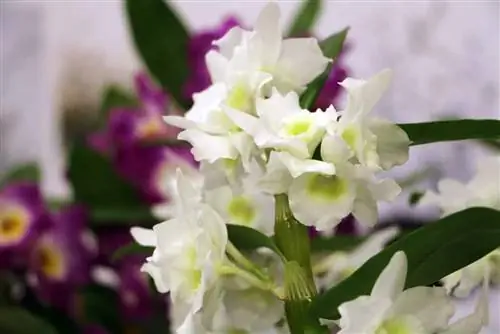
But the fact is that some cats are very sensitive, while others love to snack on the orchids and don't seem to have any problems with them at all. You can only tell which group your cat belongs to once the orchid has already believed it. You should definitely pay attention to these symptoms:
- Cat develops diarrhea and/or vomiting
- Mucous membranes, especially in the throat, are red and irritated
- Cat is sick and seems weak, listless
- Animal is hiding, doesn't want to play like usual
- Eyes appear cloudy, dull
In these cases, as a precaution, consult a veterinarian and ideally take the suspected culprit, the nibbled orchid, along with the species description (if it still exists). Based on this, the veterinarian can decide which treatment and which antidote may be necessary.
Be careful with these poisonous orchid species
There are around 30,000 different species of orchids worldwide, some of which are poisonous and others - at least for most cats - completely harmless. These popular indoor orchids are definitely poisonous and therefore unsuitable for a cat household:
- Vanilla orchid (Vanilla planifolia) and its hybrids
- Callous orchid (Oncidium cebolleta) and its varieties
- as well as the popular butterfly orchid (Phalaenopsis)
The species mentioned should be kept inaccessible to indoor cats or should always be removed from a cat apartment.
Vanilla orchid (Vanilla planifolia)
We owe the vanilla orchid the real or bourbon vanilla, which is obtained from the seed pods of this South American orchid species. However, contact with the plant, for example through eating individual parts of the plant or even through contact with the plant sap, can cause poisoning symptoms such as rashes, nausea and general malaise. This even applies if the pods or their contents, which are actually known as spices or even medicinal products, are consumed - not only people, but also cats can develop an allergy to certain foods and react to them with rashes and / or swelling of the mucous membranes.
Callous orchid (Oncidium cebolleta)
Oncidia and their relatives come mainly from the cloud forests and mountain slopes of South America. There they are called “Lluvia de Oro”, which means “golden rain”, because of the many yellow flowers. They are used to cool temperatures in their homeland, which is why we also know them as cold house orchids. Oncidia are easy to recognize because of their usually long leaves and strong bulbs. The flowers are very varied, colorful and bizarrely shaped. Eating this type of orchid and its flowers causes hallucinations in humans. Cats can also be subject to similar effects and the typical symptoms of poisoning.
Butterfly Orchid (Phalaenopsis)
The Phalaenopsis genus, which is rich in species and varieties, is probably the most popular orchid genus in the world. It currently holds a record: it is considered the best-selling potted plant in the world. These orchids are not only considered very easy to care for, they are also very flowery and have a long flowering period. However, cat owners should avoid keeping butterfly orchids because they (and their numerous hybrids, for example those created with the closely related genus Doritis) are considered mildly poisonous. Your cat won't die immediately from eating it, but depending on its constitution, the animal may become quite unwell and require an expensive visit to the vet.
The garden should also be designed to be cat-safe for outdoor cats
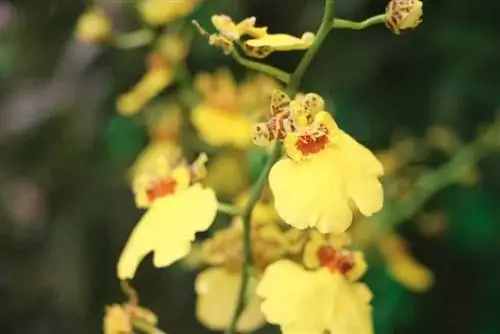
In addition to the numerous indoor orchids, gardening enthusiasts with outdoor cats should also pay close attention to what is actually growing in their garden. Not only exotic plants, but also local orchids such as the following can be fatal to our four-legged friends:
- Yellow lady's slipper (Cypripedium calceolus)
- Flesh-colored Orchid (Dactylorhiza incarnata)
- Red orchid (Orchis ustulata)
- Forest hyacinth (Platanthera bifolia)
Yellow lady's slipper (Cypripedium calceolus)
The beautiful yellow lady's slipper is probably one of the most beautiful domestic orchids. The plant is sometimes offered in a pot, but rarely thrives as a houseplant. As beautiful as this orchid is, it contains toxic and anesthetic ingredients such as cypripedin and some quinones. If you find the yellow lady's slipper in the wild, be sure to leave it alone. The very rare plant is on the Red List of Endangered Species.
Orchids
In Europe there are around 40 different species of orchids, which either belong to the genus Dactylorhiza or Orchis and, due to their close relationship with one another, often form hybrids, i.e. crosses. These native orchids are also on the Red List of Endangered Species and therefore may not be picked or otherwise disposed of. In the past, some species were used as medicinal herbs for stomach and intestinal problems, but they can cause exactly the same problems in cats.
Forest hyacinth (Platanthera bifolia)
There are numerous types of hyacinths, some of which can also be found in cultivated form in the home garden. However, the spring bloomer, which is so pretty to look at, is poisonous not only to humans but also to cats and can primarily cause skin irritation and swelling of the mucous membranes. If the cat has eaten too much, symptoms such as diarrhea and vomiting are also possible.
Conclusion
Only a few of the orchids cultivated as houseplants are actually poisonous to cats. However, for reasons that are currently unknown, many velvet paws still react with typical symptoms of poisoning such as irritation of the mucous membranes and throat as well as diarrhea and vomiting after nibbling parts of plants. For this reason, all orchids should be cultivated out of the reach of cats.

